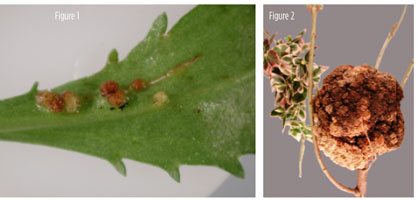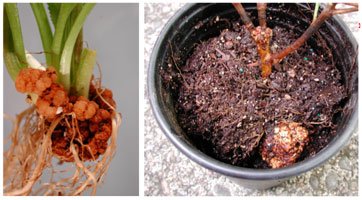9/30/2015
Crown Gall: Still Confounding Scientists and Growers Alike
Melodie L. Putnam
Crown gall is a disease that’s been examined for nearly 125 years, but frustratingly, there’s still much that remains unknown about it. Crown gall is caused by various species of the bacteria Agrobacterium, the most common being
A. tumefaciens (also called Rhizobium radiobacter). Crown gall can occur on roots, the root crown, stems or branches (I’ve never seen floral parts being affected).
Figure 1. Tiny galls, each of which is less than 1/8-in. across, have formed at wound sites on a leucanthemum leaf.
Figure 2. A massive aerial gall on Euonymus fortunei.
The galls are masses of pla

nt tissue that have experienced cell division in an unorganized manner, leading to roundish accumulations of cells that can look much like callus tissue. There’s some degree of connection with the unaffected vascular tissues, but often the ability of water to move through the galled tissue to other parts of the plant is curtailed, hence, the galls can affect vigor. In some species, root and shoot growth may be reduced and the disease can certainly affect whether you have a saleable plant. People generally shy away from plants with things that look like tumors.
The galls can vary in size from just a fraction of an inch (Figure 1) to several inches across (Figure 2). Or, in the case of trees, much larger. The galls are generally light green or cream-colored when fresh, but they tend to darken with time, and on woody plants can become hard and fractured with age. Expanding galls slough bacterial cells into the soil, especially with overhead irrigation or rainwater. The bacteria can persist on woody roots for at least two years and presumably also in mineral soils for up to that long.
Which plants are affected?
The bacteria are known to have an extremely wide host range (i.e., the range of plants in which it’s capable of causing disease) of over 90 families and thousands of species, but this information is based on one study from 1976 and is misleading. The “90 families” came from a series of inoculations to a wide variety of plants, many of which have never since seen a gall. Most isolates of the bacteria have a more limited host range than is indicated by the 1976 study, but they’re still rather flexible in their ability to infect a variety of plant species.
I’ve listed commonly affected ornamentals (and a few other species) in the accompanying table. Crown gall on Ficus benjamina and Vitis species are due to different species of Agrobacterium, which infects only ficus and vitis, respectively. Galls that form on gypsophila, loropetalum, forsythia, fraxinus and olea may look like crown gall, but aren’t, and are caused by other bacteria. The plants I’ve listed here aren’t the only ones that can be infected; I’ve focused largely on ornamentals, although many vegetables, such as tomatoes, are also susceptible.
Plants Susceptible to Crown Gall
Achillea millefolium (Yarrow)
Argyranthemum frutescens (Marguerite Daisy)
Aster spp. (Aster)
Begonia spp. (Begonia)
Chrysanthemum x morifolium (Chrysanthemum)
Coreopsis sp. (Tickseed)
Cosmos sp. (Cosmos)
Dahlia variabilis and hybrids (Dahlia)
Dianthus caryophyllus (Carnation)
Euonymus spp. (Euonymus)
Ficus benjamina (Weeping Fig)
Gaillardia x grandiflora (Blanket-Flower)
Helianthus annuus (Sunflower)
Heuchera sanguinea (Coral Bells)
Hosta spp. (Hosta)
Juglans regia (English Walnut)
Lamium maculatum (Dead-nettle)
Leucanthemum x superbum (Shasta Daisy)
Lobelia sp. (Lobelia)
Malus spp. and hybrids (Apple, Crabapple)
Osteospermum sp. (Osteospermum)
Pentas sp. (Pentas)
Perovskia atriplicifolia (Russian Sage)
Photinia sp. (Photinia)
Populus angustifolia (Willow-leaved Poplar)
Populus spp. (Cottonwood)
Populus tremula (Aspen)
Populus tremuloides (Quaking Aspen)
Prunus amygdalus (Almond)
Prunus armeniaca (Apricot)
Prunus avium (Cherry)
Prunus cerasifolia (Cherry Plum)
Prunus domestica (Garden Plum)
Prunus x (Flowering Cherry)
Pyrus communis (Pear)
Pyrus ussuriensis (Manchurian Pear)
Rosa spp. and hybrids (Rose)
Rubus spp. (Caneberries)
Salix spp. (Willow)
Stachys monieri (Betony)
Vaccinium corymbosum (Blueberry)
Verbena spp. (Verbena)
Vitis spp. (Grape)
Note: This is not a complete list, but represents commonly infected, largely ornamental, species.
How do the bacteria get around?
The crown gall bacteria can be transmitted in many ways. Besides being shed from galls, the bacteria can move passively in water, and plants irrigated by flooding benches or floors may be at risk if the disease is present somewhere in the crop. Plants growing in infested field soil will often become diseased, especially if the site is wet. The bacteria are thought to be spread by common nursery operations, such as pruning, pinching and mowing to reduce the height of plants.
Crown gall bacteria are systemic in some crops
In a number of species—such as argyranthemum, chrysanthemum,
Ficus benjamina, Rosa,
Juglans regia and vitis—the bacteria are known to be systemic. I suspect leucanthemum is also in this category. There are likely more plants in which the bacteria can be systemic, but which plants and how commonly it occurs is poorly understood. It’s important to keep in mind that in plants where the bacteria can become systemic, they’re not uniformly distributed throughout the tissues. The bacterial cells are limited to the water conducting cells (the xylem) to which they attach themselves and the extent of internal movement will vary depending on time of year, environmental conditions, degree of susceptibility of the plant host and the bacteria themselves.
In grapes that have been root-inoculated, the bacteria were found to have moved nine inches into stems after three to five weeks. However, grapes are commonly grown with a single stem, and the distribution of bacteria in multi-stemmed plants remains unclear. Presumably if the initial gall formed on a single root, only the stem, which had continuity with the xylem column connecting with that root, could become galled. It’s not known whether there’s significant lateral movement of Agrobacterium between xylem cells.
When infection occurs initially through the roots, galls may be entirely below the soil surface and be unobserved. This means it’s possible to take cuttings from infected material without realizing it until after the cuttings have been shipped. Unfortunately, your customers will be able to figure it out.

Galls in systemically infected plants form after some sort of injury. For plants outside and unprotected, tiny cracks from freezing temperatures can be the site of gall formation; for greenhouse plants, galls often show up at pinch sites or at the base of cuttings that are being rooted (Figure 3). In response to wounds, the plants form defense compounds, such as phenolics. Unfortunately, these compounds also act as a signal to the bacteria. Once the wound compounds are generated, the bacteria detach from the xylem cell walls and are carried upward with water during evapotranspiration to the wound site where they initiate galls.
Figure 3. Galling often occurs at the base of cuttings taken for rooting. Here, multiple galls formed on a leucanthemum cutting.
Figure 4. This photinia, in a 2-gal. pot, has extensive galling under the soil surface, part of which is visible here. A stem gall is also present.
In plants in which the bacteria aren’t thought to be systemic, galls usually form on the roots (Figure 4) that have come into contact with bacteria in the soil or from water contaminated with the bacteria. It’s likely galls also may be formed at pruning sites if cutting tools are contaminated with the bacteria.
How can crown gall be controlled?
Once a plant has become infected with Agrobacterium, there’s no cure. Copper products, one of the few compounds available for use against bacterial diseases, are completely ineffective for preventing or treating crown gall once infection has occurred. Some strains of the crown gall bacteria can be controlled with an antibiotic-producing antagonist contained in the products Nogall and Galltrol. Both products can work quite well to prevent infection in some plants, such as Prunus, if cuttings are treated prior to planting. However, if the cuttings are from a systemically-infected plant, an external treatment of any type may be ineffective. In addition, some isolates of the crown gall bacteria simply aren’t susceptible to these products. A third compound, Gallex, is marketed to control crown gall in woody plants, such as fruit and nut trees and some ornamentals (Rosa, euonymus, salix). This product is applied to visible galls to kill them, but galls may recur, and again, Gallex has no activity against systemic infections.
Prevention is control
Lack of effective control compounds means prevention is the only sure way of managing disease. Since some plants, not all of which are currently recognized, may act as a systemic host, it’s best not to take cuttings or propagate from diseased plants. An educated work force at all levels can help to eliminate problems as they arise. Educate staff to recognize galls on bare root cuttings so they can be discarded and not planted.
Where irrigation isn’t automated, train waterers to be alert for galls on plants that are particularly susceptible, such as leucanthemum, argyranthemum, chrysanthemum, euonymus and Rosa. All symptomatic plants should be discarded, along with the potting mix they’re in. Fields infested with the crown gall bacteria shouldn’t be planted with susceptible crops, or ideally, be used for raising potted plants that aren’t in contact with the soil. Pruning tools are thought to transmit the bacteria, so they should be disinfected as frequently as possible.
Which sanitizers work best? In spite of over 100 years of research on crown gall disease, we still don’t know the best way to disinfect tools. For Agrobacterium, bleach (10% of household formulations) and products containing quaternary ammonium or oxidizing agents can work well at disinfecting hard surfaces, but the effective contact time is usually five to 30 minutes. In my laboratory, we’re currently conducting research to see if it’s possible to identify products that will allow a shorter contact time with no loss of efficacy.
GT
Melodie L. Putnam is Director of the Oregon State University Plant Clinic in Corvallis, Oregon.